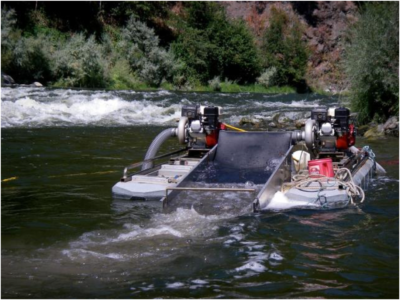Look Out Below!
U.S. Supreme Court Signals Interest in Key Environmental Law/Federal Preemption Case From California
The U.S. Supreme Court today signaled that it is seriously considering whether to review an important environmental law case from California–one in which the California Supreme Court previously ruled that California’s ban on environmentally-damaging suction dredging in state rivers is not preempted by federal law.

The case is People v. Rinehart, U.S. Supreme Court No. 16-970. Last summer, the California Supreme Court unanimously rejected a novel defense raised by the defendant in a criminal environmental enforcement prosecution: that the federal Mining Act of 1872 preempts state law under which the defendant was convicted of illegal suction dredging in a Northern California river located within a national forest. (Suction dredging, a mining technique used by commercial and amateur miners to extract precious metals from waterways, is currently banned in California because of the often-profound damage it inflicts on river ecosystems.) Miner Rinehart argued that federal law–most prominently the Mining Act–preempts the state suction dredging ban because he was mining within the boundaries of a national forest. The state ban, he unsuccessfully argued, can’t be enforced on federal lands.
Rinehart, represented by the Pacific Legal Foundation, has petitioned the U.S. Supreme Court to review his case and reverse his conviction under California law. In today’s order, the Supreme Court “invited” the views of the Trump Administration’s acting Solicitor General as to whether Rinehart’s petition for certiorari should be granted. (While styled as an invitation, such an order is traditionally and understandably viewed by U.S. Justice Department attorneys as a directive from the justices, rather than an option.)
While not a guarantee that the Supreme Court will grant review, the Court’s order is significant because it reveals that the Rinehart case is, at a minimum, on the justices’ “A” list, and that at least some of them believe the case is potentially “cert-worthy.”
Legal Planet colleagues Sean Hecht, Eric Biber and I have all previously blogged about the details and significance of the California Supreme Court’s 2016 Rinehart decision. But now the ultimate fate of that important preemption/federalism decision is in question.
There’s a most interesting subplot to the Rinehart case now that it’s before the U.S. Supreme Court: the Obama Justice Department surprised some observers when in 2015 it filed a friend-of-the-court brief with the California Supreme Court arguing for the proposition that California’s suction dredging ban is not preempted by federal law and can be enforced even within national forests. It’s rare for the federal government to appear as amicus in state court cases to argue against federal preemption, and the Justice Department’s arguments likely were quite influential before the California Supreme Court. So it will be most interesting to see whether the Trump Administration’s Justice Department will adhere to that position in the U.S. Supreme Court or, instead, switches sides and argue before the High Court that California’s suction dredging ban should be (pardon the expression) “trumped” by federal law.
That decision, in turn, will reveal a great deal about President Trump’s professed affection for “states’ rights”: is that a consistent principle underlying the Trump Administration, or does it only apply when states seek to weaken, rather than strengthen, environmental laws?
Reader Comments
3 Replies to “Look Out Below!”
Comments are closed.







Thanks for posting about this, Rick.
One other wrinkle in the case: There is another case involving a very similar statute and preemption claim pending in the 9th Circuit Court of Appeals, in a case called Bohmker v. Oregon. The state of Oregon won in front of the federal district court and the miner appealed. As it did in People v. Rinehart, USDOJ also filed a brief in Bohmker supporting the state’s position against preemption.
Although it’s rare, as you say, Rick, it’s also true that DOJ’s position in these cases is generally consistent with how the Department of Interior has applied the law over the past two decades.
Eric and I, along with colleagues, filed amicus curiae briefs in both cases supporting the position of both California and Oregon (and U.S. DOJ) against preemption.
The possibility of a grant of certiorari by the U.S. Supreme Court seems particularly odd here, since the 9th Circuit case is still pending. Ordinarily, the Court would allow the cases to resolve and decide whether to review the issue after decisions by multiple courts. That approach would seem particularly apt where, as here, a decision by the 9th Circuit one way or the other would presumably be binding authority on future federal courts in California.
Regardless, it will be interesting to see how this goes. It’s possible – maybe even likely – that the federal government will switch positions in response to the Court’s invitation, contradicting its brief in the pending 9th Circuit case.
Here’s a news article with some discussion of the Bohmker case:
https://www.law360.com/articles/854319/feds-law-profs-back-oregon-in-9th-circ-mining-appeal
Isn’t this article making assumptions about the presumably dangerous practice of dredging? No scientific evidence was presented in court to prove this statement. This article was not written with a non biased report. The miners in this case presented scientific evidence of rivers being cleaned of lead. Pounds and pounds of it. They showed how much mercury was captured and removed as well. They also demonstrated how dredging has reversed the cementing of gravels caused by old hydrolic mining thereby restoring fisheries. Not one of the claims of damage was scientifically shown to be true. One such report showed the Auburn river at full flood stage and claimed it to be evidence of dredging dangers. Yet all this evedince to the contrary and you failed to mention any. You should be ashamed.
The author Richard Frank states this in his article “(Suction dredging, a mining technique used by commercial and amateur miners to extract precious metals from waterways, is currently banned in California because of the often-profound damage it inflicts on river ecosystems”
Richard apparently doesn’t know anything about this topic as there have been 3 Environmental Impact Reviews performed and NONE of them show that suction dredging does ANY harm to ANY Ecosystem as claimed by the Karuk Indians or the Center for Biological Diversity.
Look at what happens every year in California to the creeks and rivers as they flood and toss boulders like marbles and cause mudslides all over. If the plume from a dredge killed fish as is claimed then every spring ALL the fish would be dead.
But it doesn’t happen. In FACT as we work in the streams, we the miners recover LEAD in the form of can solder from the old days, sinkers from fishermen and bullets from hunters. Lead is harmful to people as is the mercury we recover and remove.
The citizens of the state of California should Thank us and possibly PAY us for this service!
Report FACTS Richard not the liberal version of Snowflake truth aka Lies. Just FYI I will be sharing your fabrication with my colleagues as well as my response.